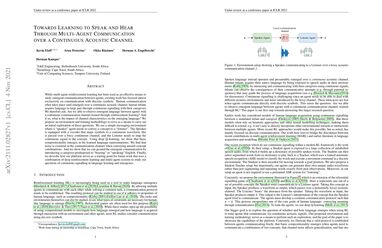Towards Learning to Speak and Hear Through Multi-Agent Communication over a Continuous Acoustic Channel
Multi-agent reinforcement learning has been used as an effective means to study emergent communication between agents, yet little focus has been given to continuous acoustic communication. This would be more akin to human language acquisition; human infants acquire language in large part through continuous signalling with their caregivers. We therefore ask: Are we able to observe emergent language between agents with a continuous communication channel? Our goal is to provide a platform to begin bridging the gap between human and agent communication, allowing us to analyse continuous signals, how they emerge, their characteristics, and how they relate to human language acquisition. We propose a messaging environment where a Speaker agent needs to convey a set of attributes to a Listener over a noisy acoustic channel. Using DQN to train our agents, we show that: (1) unlike the discrete case, the acoustic Speaker learns redundancy to improve Listener coherency, (2) the acoustic Speaker develops more compositional communication protocols which implicitly compensates for transmission errors over a noisy channel, and (3) DQN has significant performance gains and increased compositionality when compared to previous methods optimised using REINFORCE.
PDF Abstract


 Clotho
Clotho